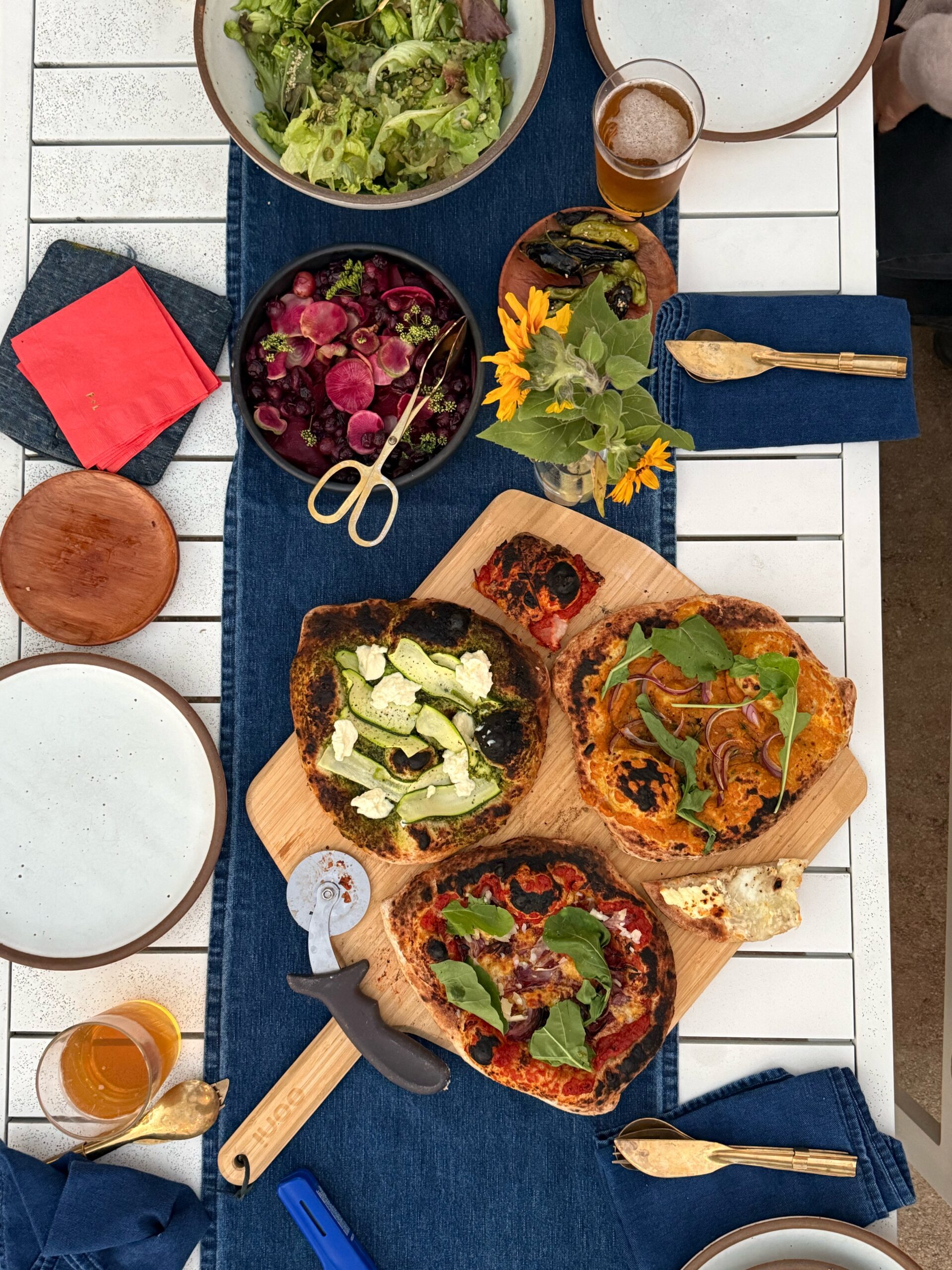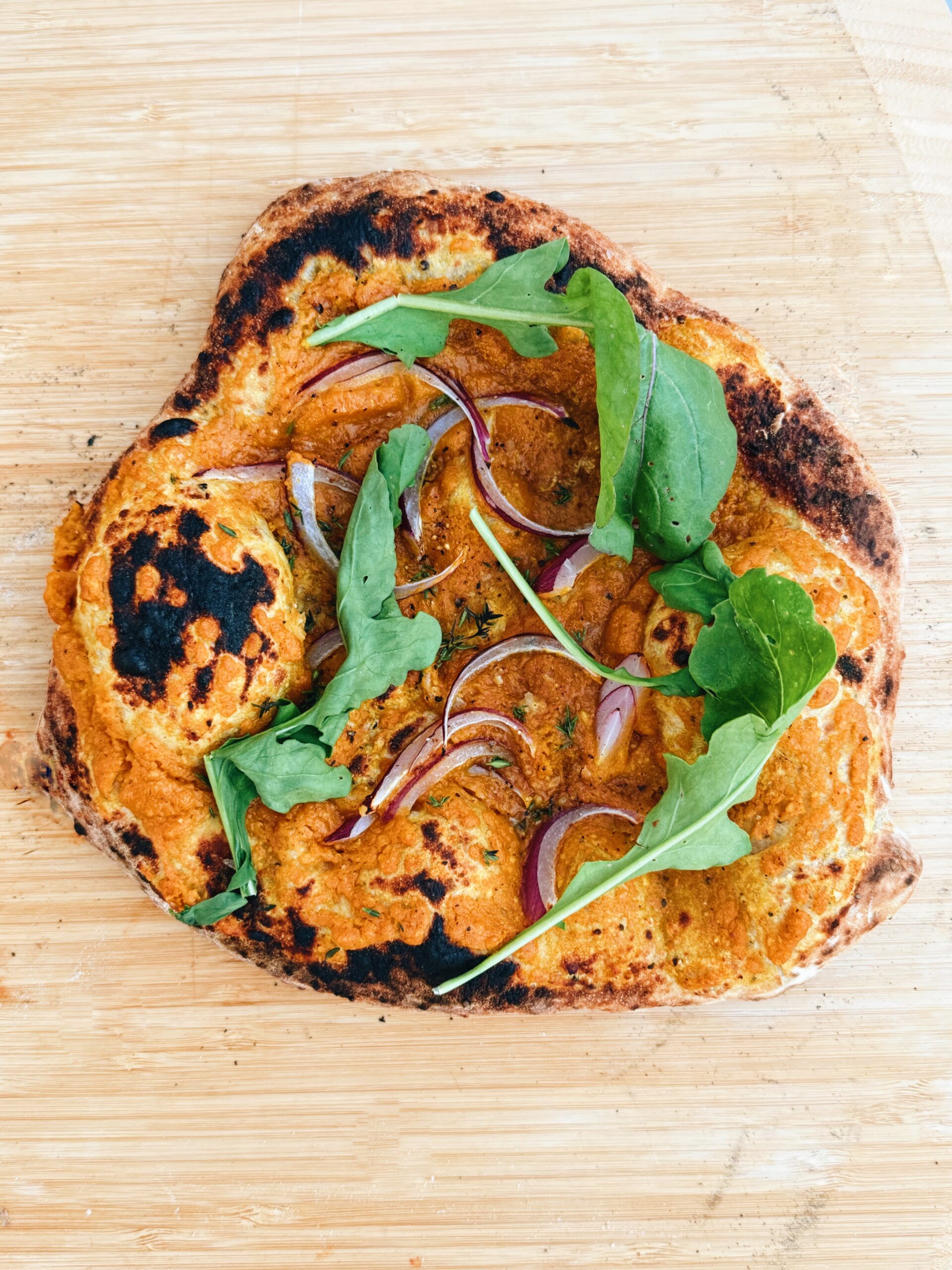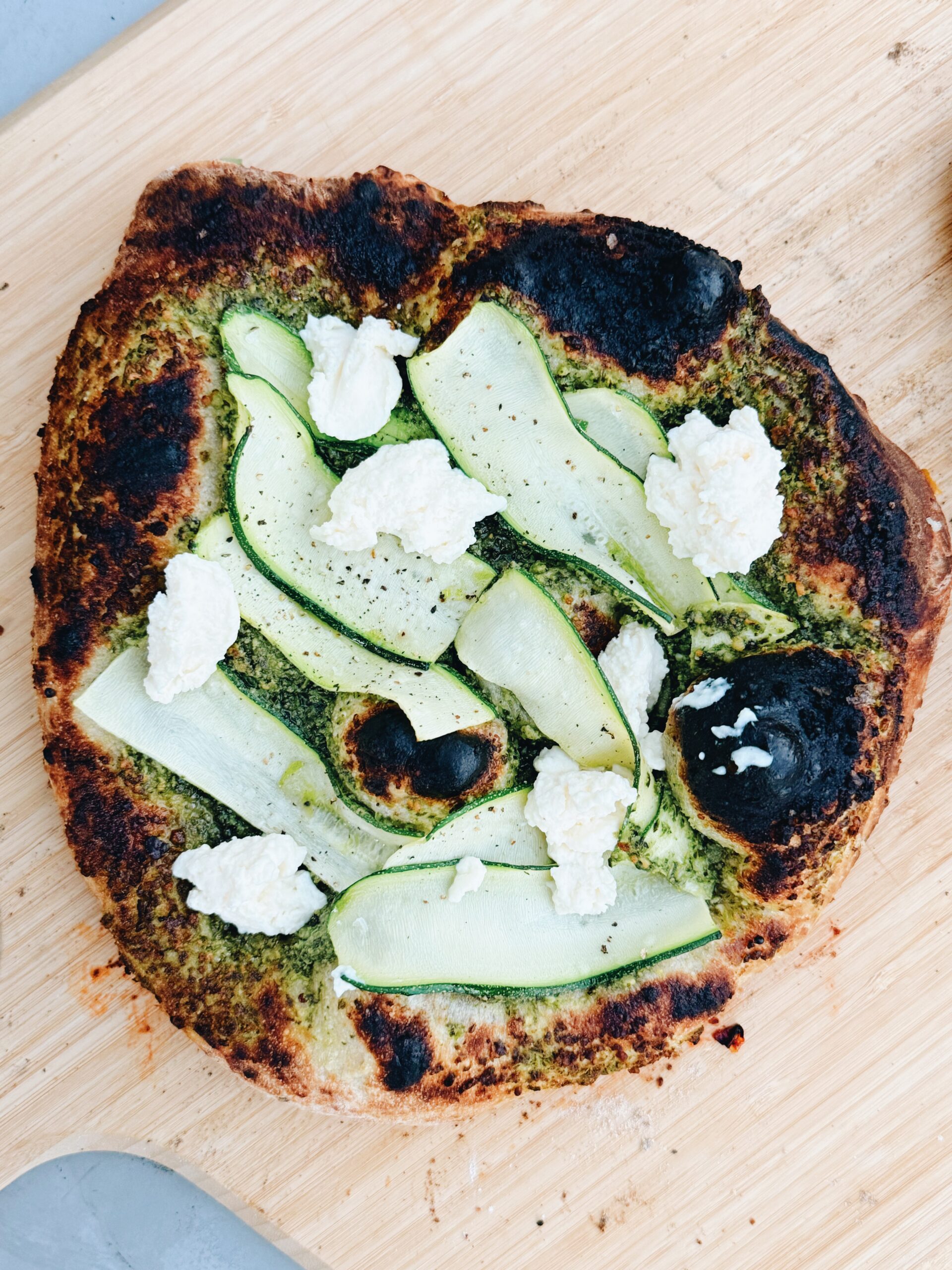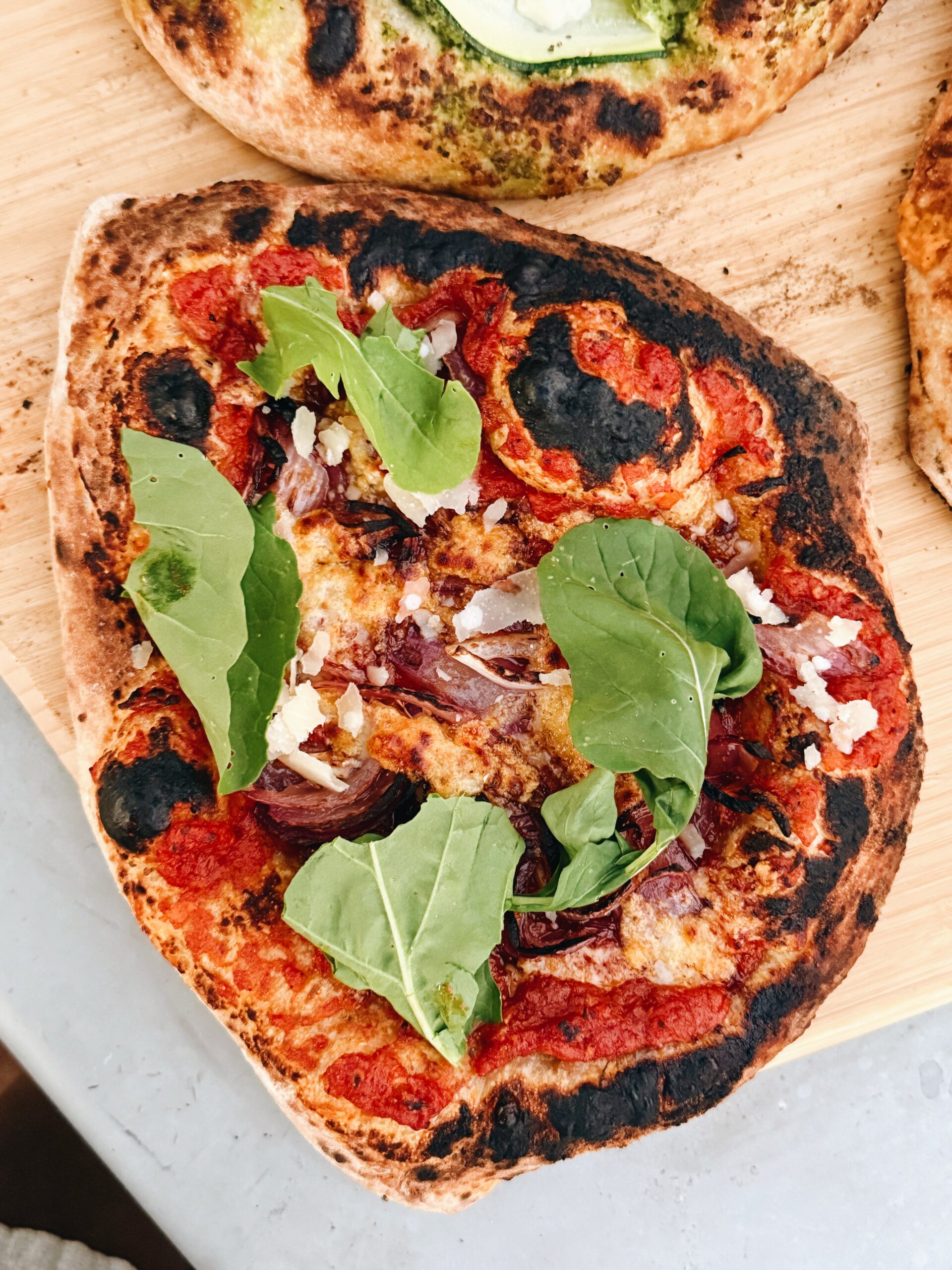

Is there anyone who doesn’t love pizza? If only all pizzas loved all of us back.
It’s not my goal to burst your pizza bubble. But it IS my intention to point out that there’s a better way of “doing pizza” if we want to honor our digestive systems and “internal weather.” There’s a very strong chance that your favorite pie is a digestive imbalance waiting to happen. But with these pizzas in your pocket (er, oven) enjoying a pizza that loves you as much as you love it IS possible.

Pizza is comfort, joy, and instant nostalgia — but traditional versions can feel heavy, greasy, or off-balance for the body.
First, let’s acknowledge that pizza – the Italian way – is simple, and quite balanced! But when we stray from the Italian blueprint of sourdough crust, simple tomato sauce, seasonal ingredients and just a bit of cheese, spices and garlic, things start to get wonky – especially when it comes to digestive health. The meat-lovers, cheese-lovers, deep dish situations that grace so many menus here in the U.S. and elsewhere we really start to turn a simple, rather healthy meal into…something else entirely.
The beef with these pizzas isn’t so much about them being “healthy” as it is that they are incredibly challenging for the digestive system, often pushing our frequently out-of-balance bodies further into a state of disarray.
Most “regular” pizzas present the following digestive struggles:
Heavy, refined flour crust
Standard white flour is dense, dry, and low in fiber.
It tends to slow digestion and can leave the gut feeling sluggish, especially for Vata or Kapha types.
Sourness and fermentation are usually minimal, so there’s little to help break it down before it hits your stomach.
Highly processed cheese
Dairy-heavy and often high in fat and salt.
Hard cheeses or large amounts can be heating for Pitta and heavy for Kapha.
For Vata, cold, hard, fatty cheese can aggravate dryness and create bloating or gas.
Acidic tomato sauce
Traditional tomato sauces are acidic, which can irritate Pitta types or sensitive stomachs.
Often heavily spiced with chili or oregano, which adds heat for Pitta and sometimes excess dryness for Vata.
Oily or greasy toppings
Pepperoni, sausage, or extra oil add heaviness, slowing digestion and leaving you feeling lethargic.
For Kapha types, this combination can increase sluggishness; for Pitta, it can aggravate internal heat.
Overeating risk
Pizza is easy to overeat because it’s rich, calorie-dense, and carb-heavy.
Large portions put a strain on agni (digestive fire), leaving you bloated, tired, or gassy.
Sound familiar?
BUT, when we apply a little attention to our slices, we get to enjoy them AND without discomfort. Or our partner’s farting in bed. Or feeling like we have a rock in our guts!
Adjusting our pizza recipes to suit our doshas isn’t about restriction or “healthy substitutions,” but rather smart combinations. By understanding our unique constitutions (prakruti) and present state of being (vikruti) we can build a pizza that suits what our bodies truly need while still indulging in our cravings for excellent ‘za. By choosing the right crust, sauce, toppings, and spices, pizza becomes more than just a meal — it’s a micro-practice in balance. Each slice can stabilize scattered energy, calm internal fire, or awaken sluggishness, depending on the intention behind it. And we thought there was a real power in pizza before!

While the general needs of a human digestive system are the same, (ie: everyone’s belly is happier when we don’t eat beans, meat, and dairy together) the individual needs of our prakruti (or individual doshic constitution) has it’s own definition of what’s healthy, balancing…good.
To speak to this, let’s address the substantial differences between the three doshas — Vata, Pitta + Kapha.
Vata dosha is…
Comprised of ether + air. Individuals with the highest amount of vata dosha in their constitutions are typically creative, free-thinking, spontaneous. They don’t typically have a lot of “systems” or structure in their lives, and they like it this way. Their body types are typically thin, lithe, often tall, and they’re prone to digestive conditions because the seat of vata is in the colon, and their bodies are already quite cold. Add to this that vatas love to move, and so they actually are creating more wind/coolness in their lives with all the shaking + doing. The qualities of this dosha are cold, rough, dry, mobile and subtle, and these individuals benefit by foods/practices that emphasize warm, smooth, moist, grounding + dense qualities (the opposites.)
Pitta dosha is…
Comprised of fire + water. Individuals with the highest amount of pitta dosha in their constitutions are typically focused, driven, high-achieving and intense. They love structure, love goal setting, and love the process of achieving their goal. They thrive on being able to check things off their to do list, and they will stop at nothing (not even inconvenience or personal discomfort) to get that personal pat on the back. Structure is the way pitta loves to live, and they start to become edgy when things don’t follow their design. Their body types are typically strong and sturdy, and they’re also prone to digestive conditions because the seat of pitta is in the stomach, and they’re already quite “firey,” not to mention that the intensity they bring to the world creates a bit of fire. The qualities of this dosha are hot, sharp, oily, light, pungent, sour, spreading and liquid. And, these individuals are benefitted by emphasizing the opposite qualities in their foods + lifestyles: cool, mild, heavy, dry, sweet, bitter + astringent.
Kapha dosha is…
Comprised of water + earth. Individuals with the highest amount of kapha dosha in their constitutions are typically stable, consistent, slow acting, methodical, stoic thinkers who require structure, stability and calm-collectedness to function. They thrive on long projects, deep thoughts, efforts of endurance and loyalty, and are highly annoyed or disoriented when things change, move or flow too quickly or too often. Deep thinkers, and those recognized for lifetime achievements, are often high in kapha. Their body types are typically dense, strong and sometimes on the extra muscular side, and they’re prone to inactivity or a sense of the sedentary because the home of kapha in the body is behind the heart and lung space (which also makes them prone to heartache and breathing issues.) The qualities of this dosha are heavy, slow, cold, oily, smooth, dense, soft, stable and cloudy and so they’re well served by the opposites: light, sharp, hot, dry, rough, subtle, mobile, clear — all of which help to shake up, envigorate and enliven individuals of this dosha.

Just by reading these descriptions, I hope you can hear just how the heavy, oily, dense qualities of most of our standard slices aren’t of service for athletic/active constitutions or digestive systems. If we were all trying to win the couch olympics, and didn’t care about digesting or assimilating our meals then any old pizza would do. But as it is, we have a little focused redesigning to do.
All constitutions benefit from choosing one protein – beans, meat or cheese – and leaving the others by the wayside. This means that pizzas that combine heavy meats and cheeses aren’t a great choice for any body.
If you’re a vata you typically thrive on warmth, grounding, and moisture, so your perfect pizza is all about creating a comforting, stabilizing experience. You have the most “pizza bandwidth” because the sheer nature of this food is dense and grounding. Start with a slightly thick, whole-grain crust such as sourdough, spelt, or wheat to anchor scattered energy. For the sauce, creamy or sweet bases like roasted squash, pumpkin, or a mild tomato with tahini or olive oil work beautifully. Toppings should be soft and cooked — think caramelized onions, roasted root vegetables, and wilted greens — paired with mild cheeses or cashew cheese if you’re a vegan. Weaving in spices such as cumin, cinnamon, and thyme round out the flavor. To finish, drizzle a touch of warm ghee or olive oil to deepen the grounding effect your body needs…and wants.
If you’re a pitta, you’re all about fire and intensity, so the ideal pizza for this dosha cools, soothes, and balances internal heat. Spicy, super garlicky or extra cheesy pizzas will be your kryptonite and not in the good way. You’re likely to experience inflammation of the gut if your choices aren’t aligned with this goal. Choose a lighter whole-grain or thin sourdough crust to avoid heaviness (yes, this is as easy as avoiding the thick or deep dish pizzas!) The sauce should be cooling and herb-forward — herby-based pestos are perfect — or a lightly sweetened tomato base. Top with juicy or sweet vegetables and fruits, such as zucchini, figs, pears, or fennel, along with mild cheeses or ricotta or goat cheese to calm fiery tendencies. Avoid spicy or overly garlicky flavors and heavy oils. Pitta pizza should feel refreshing, light, and hydrating while still satisfying so a little fresh salad after your pizza, or a squeeze of lemon over the top are a game changer for you.
If you’re a kapha, you benefit from light, energizing, and stimulating flavors that counteract heaviness and stagnation. Pizza is – in essence – not a great alignment with your constitution, or your digestive tendancies. Start with a thin, crisp crust made from lighter grains like buckwheat, quinoa, or spelt – avoid sourdough and wheat. The sauce should be warming and lightly spiced, such so tomatoes and spices really hit the spot; this awakens digestion. Choose toppings that are pungent, bitter, or lightly bitter — broccoli, arugula, mushrooms, cooked greens and onions work well — and keep cheese minimal or opt for lighter varieties like pecorino or parmesan. Finishing touches like lemon zest, fresh herbs, or a small sprinkle of chili flakes provide an energizing kick. Kapha pizza should leave you feeling invigorated and satisfied without weighing you down.

There are three recipes below, tailored to suit the needs of each of the Ayurvedic doshas: vata, pitta and kapha. There are a couple of different ways for you to choose your recipe. If you know your prakruti (perhaps because you’ve taken my dosha quiz?!) you can choose the recipe that suits your dosha. But, if you know that you have a specific imbalance of dosha (most of us do even the tiniest bit) then you’ll likely want to make the pizza that is most balancing for that out-of-balance dosha. For example, if you know you have elevated kapha, choosing the kapha pizza is appropriate. If you’re a pitta, and you have a pitta imbalance, the pitta recipe is right for you. And, if you’re a vata dosha with a pitta imbalance you likely want to choose the pitta pizza instead of the vata one, etc.
There are lots of ways to make a pizza for each dosha, and the recipes below are just one of those ways. As you cook and eat these recipes, you’ll naturally think of foods that might be different but still aligned that you could include to mix up the recipe and the experience.
For Vata: Your pizza recipe below features sweet, grounding squash sauce, tempered caramelized onions, peppery arugula and optional cheese because the density of dairy can be helpful for grounding energy and balancing digestion.
For Pitta: Your pizza recipe below is a pesto pie with zucchini and dollops of fresh ricotta. The coolness of this combination soothes and balances digestion.
For Kapha: Your pizza recipe below is a spiced tomato pie with onions, arugula and parmesan, because this light, long-fermented cheese won’t weigh you or your digestion down like heavy, dense, creamy cheeses.
Give these a try + enjoy!
That's ok, just sign up or log in to see this recipe.